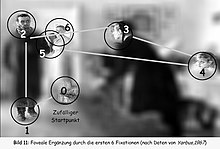Eye movement
Eye movements are used by a number of organisms (e.g. primates, rodents, flies, birds, fish, cats, crabs, octopus) to fixate, inspect and track visual objects of interests.These signals travel along the optic nerve fibers to the brain, where they are interpreted as vision in the visual cortex.Primates and many other vertebrates use three types of voluntary eye movement to track objects of interest: smooth pursuit, vergence shifts[1] and saccades.These muscles arise from the common tendinous ring (annulus of Zinn) in the orbit (eye cavity), and attach to the eyeball.So the eye movement constantly changes the stimuli that fall on the photoreceptors and the ganglion cells, making the image clearer.To get a clear view of the world, the brain must turn the eyes so that the image of the object of regard falls on the fovea.To see a quick demonstration of this fact, try the following experiment: hold your hand up, about one foot (30 cm) in front of your nose.This demonstrates that the brain can move the eyes opposite to head motion much better than it can follow, or pursue, a hand movement.In most vertebrates (humans, mammals, reptiles, birds), the movement of different body parts is controlled by striated muscles acting around joints.Typically, when presented with a scene, viewers demonstrate short fixation durations and long saccade amplitudes in the earlier phases of viewing an image.[16] It has also been found that eye movement behaviour in scene viewing differs with levels of cognitive development - fixation durations are thought to shorten and saccade amplitudes lengthen with an increase in age.[25] Cross-culturally, it has been found that Westerners have an inclination to concentrate on focal objects in a scene, whereas East Asians attend more to contextual information.[27] This variability is mostly due to the properties of an image and in the task being carried out, which impact both bottom-up and top-down processing.[30] Factors which affect top-down processing (e.g. blurring) have been found to both increase and decrease fixation durations.

voluntaryinvoluntaryorganismsprimatesrodentsoctopusrapid eye movementREM sleepsix musclesretinaphotoreceptorselectrochemicaloptic nervevisual cortexsmooth pursuitsaccadesfrontal lobeExtraocular musclescommon tendinous ringeyeballlateralmedialinferiorsuperiorrecti musclessuperior obliquelateral rectusmedial rectusinferior rectussuperior rectussuperior oblique muscleinferior oblique musclelateral rectus musclemedial rectus muscleinferior rectus musclesuperior rectus muscleantagonistic pairsoculomotor nervetrochlear nerveabducens nervecranial nervesvisionfacilitate trackingCerebral cortexfrontal eye fieldsmedial eye fieldssupplementary eye fieldsParietal lobeLateral intraparietal cortexmiddle temporal areamedial superior temporal areaOccipital lobeCerebellumMidbrainPretectal areaSuperior colliculusreticular formationcranial nerve nucleiParamedian pontine reticular formationNucleus prepositus hypoglossiVestibular nucleiMedial longitudinal fasciculusGaze (physiology)ductionversionvergencefixationalvestibulo-ocular reflexoptokinetic reflexpursuit movementsconvergencedepth perceptionSaccadefixational eye movementUniversity of South AustraliaUniversity of Stuttgartpersonality traitsartificial intelligencevisual acuitycorresponding points of the two retinasdouble visionvertebratesHering's law of equal innervationSherrington's law of reciprocal innervationEye movement in readingEye movement in music readingEye movement in scene viewingcognitive developmentluminanceblurringdiplopianystagmussquintalignment surgeryMyasthenia gravisrhabdomyosarcomaCongenital fourth nerve palsyDuane syndromeInternuclear ophthalmoplegiaOphthalmoparesisOpsoclonusSixth (abducent) nerve palsyVision therapyEye movement desensitization and reprocessingoculomotor nerve palsyinferior obliqueHarada-Ito procedureanatomical terminologyAccommodation (eye)Convergence micropsiaDissociated vertical deviationEye trackingGaze-contingency paradigmListing's lawMicrosaccadeOcular tremorOrthoptistOculesicsStrabismusProgressive supranuclear palsyComputer processing of body languageCiteSeerXWayback MachineBibcodeOptical illusionsAfterimage